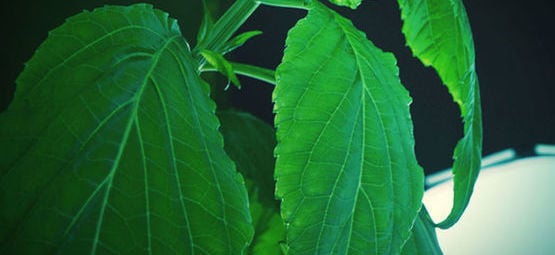How To Make Salvia Divinorum Extract From Dry Leaves
If you grow your own Salvia plants, why not make your own extracts? With a little kitchen chemistry you can easily produce a potent concentrate yourself.
There are many different possibilities to make a concentrate, but the following tutorial is both as simple and efficient as it gets. The first part of the extraction is completely harmless because only water is used, but the second stage is potentially dangerous due to the used solvent - acetone.
Acetone is highly flammable and its vapors are toxic, so make sure the place you work in is well ventilated and that there is no red-hot surface or open flame - even a simple spark caused by static electricity can cause a disaster! It should also be noted that acetone dissolves plastic, so this must be avoided when the solvent comes into play. In most countries you can buy acetone in either a drugstore, in a hardware store or on amazon.
To make your extract, you will need the following:
- 100 grams Salvia divinorum (preferably whole leaf or large pieces)
- Several coffee filters
- Coffee grinder
- 1 large mixing bowl
- 1 large piece of muslin or cheesecloth
- 4 liters of distilled water (cool, but not cold)
- 1 large glass baking dish (20 x 30cm or so)
- 2 1l mason jar (must be glass)
- 1 wire strainer (15cm or so, to fit the coffee filters comfortably, MUST NOT be plastic)
- 1 small glass dish for evaporation (we use one that is 13cm in diameter and 8cm tall)
- 2 liters of acetone (do not buy anything labeled "extra strength" or such and please evaporate roughly 50ml prior to use on a clean glass surface to be sure it does not leave any residue, if it does, do not use it)
The process - step by step
-
Finely crush the leaves by hand. Do not use a coffee grinder at this moment. Place your leaves in the bowl and add distilled water - add enough to submerge all the leaves. Allow this to sit for 7 minutes.
-
Separate the water from the soaked leaves using the cheesecloth or muslin cloth. Gently squeeze most of the water from the soaked leaves. The water can be poured away. Don't worry, Salvinorin is insoluble in water, but you have just removed about 12 grams of gooey resins from the final product.
-
To dry the leaves, place them in the glass baking dish and put them in the oven at 95-100°C, turning and fluffing them every couple of hours. Let the leaves remain in the oven until they are completely dry, before taking them out to reach room temperature.
-
Remove the amount of leaf you want to use to eventually put the concentrate back on. For a 5x concentrate 20g, for a 10x concentrate 10g, for a 20x concentrate 5g and so on. Now you can grind the leaves that are to be concentrated in the coffee grinder to a powder. Don’t powder the leaf you set aside. Beyond this point you must avoid anything made from plastic as the acetone would dissolve it.
-
Place the powdered leaf into one of the mason jars and cover it generously with acetone - if the seal on your jar contains plastic, which it very likely does, make sure it does not come in contact with the acetone. To avoid this, one option is to carefully put a layer of aluminum foil over the mouth of the jar and then close the lid. Let this solution sit for 24 hours, stirring it every now and then with a glass or metal stirring rod.
-
After those 24 hours, place a coffee filter in the strainer and pour your solution through the filter into the second jar.
-
Place the leaf back into the first jar, add more acetone and repeat the straining a second time. After 24 hours more, adding the second strained liquid to the first. You can repeat this a third time, but two soaks will have extracted out almost everything.
-
Now pour the acetone solution you made into the glass baking dish and allow the acetone to evaporate down until only about 250ml remain.
-
Add the crushed leaf (the 10g or 20g you set aside 2 days ago from step 4) into the small evaporating dish and pour the remaining acetone solution from the baking dish onto it.
-
When this has evaporated to the point where the leaf is just moist and no visible liquid left, add a few tablespoons of acetone and use the leaf to wipe off the resin which has settled on the side of your dish.
-
As these last few spoons of acetone evaporate, be sure to stir often to prevent more resin from accumulating in any certain area. When this is dry, your 5x (well, roughly*) concentrate is ready for use. Make sure absolutely every last bit of acetone has evaporated, you don’t want to smoke any acetone. Let it sit for 1 or 2 days at least before using.
*The potency and quality of home-made extracts depends on the source material and can vary greatly.
Disclaimer: We want to make clear that we reject all responsibility for any outcome of the above tutorial. We do not accept any liability whatsoever. Make sure you understand the laws in your country and the risks involved when working with chemicals.
-
 6 min
13 May 2025
Salvia divinorum: Everything you need to know
Salvia is a weird and wonderful hallucinogen that originates in South America. In this article, we're going in-depth and giving a comprehensive overview of everything you need to know about Salvia...
6 min
13 May 2025
Salvia divinorum: Everything you need to know
Salvia is a weird and wonderful hallucinogen that originates in South America. In this article, we're going in-depth and giving a comprehensive overview of everything you need to know about Salvia...
-
 3 min
26 July 2022
How To Grow Salvia Divinorum
Otherwise known as the “sage of the diviners”, Salvia divinorum is a plant species with hallucinogenic properties. While its beginnings are rooted in Mexican culture, it has garnered huge...
3 min
26 July 2022
How To Grow Salvia Divinorum
Otherwise known as the “sage of the diviners”, Salvia divinorum is a plant species with hallucinogenic properties. While its beginnings are rooted in Mexican culture, it has garnered huge...
-
 3 min
13 June 2019
How To Make Salvia Divinorum Tea
Salvia is unique among psychedelics, both in its effects profile and its pharmacology. It's often viewed as bizarre rather than pleasant, but for intrepid explorers of the mind, it's a vital part...
3 min
13 June 2019
How To Make Salvia Divinorum Tea
Salvia is unique among psychedelics, both in its effects profile and its pharmacology. It's often viewed as bizarre rather than pleasant, but for intrepid explorers of the mind, it's a vital part...
-
 4 min
25 February 2018
How To Process Your Salvia Divinorum Plant
If you want to have properly dried leaves of a Salvia divinorum plant, check out this article to see how to process them correctly for ingestion. See which techniques are most efficient and which...
4 min
25 February 2018
How To Process Your Salvia Divinorum Plant
If you want to have properly dried leaves of a Salvia divinorum plant, check out this article to see how to process them correctly for ingestion. See which techniques are most efficient and which...





 United States
United States












